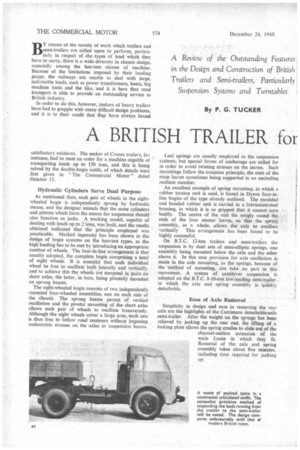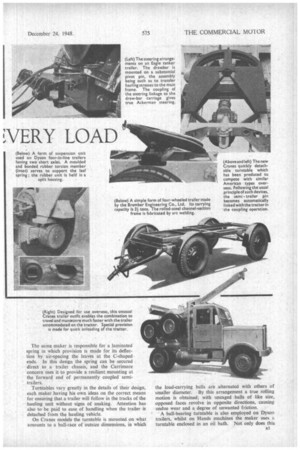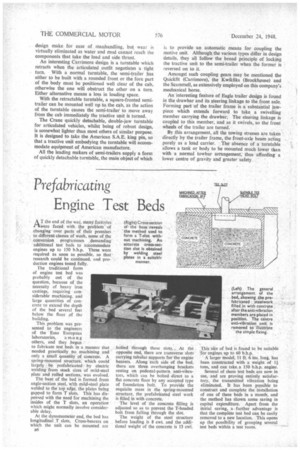A BRITISH TRAILER for
Page 38

Page 39

Page 40

If you've noticed an error in this article please click here to report it so we can fix it.
;VERY LOAD
By P. G. TUCKER
A Review of the Outstanding Features in the Design and Construction of British Trailers and Semi-trailers, Particularly Suspension Systems and Turntables
BY reason ot the variety of work which trailers and semi-trailers are called upon to perform, particularly in respect of the types of load which they have to carry, there is a wide diversity in chassis design. especially among the heaviest classes of machine. Because of the limitations imposed by their loading gauge, the railways are unable to deal with large. indivisable loads, such as power transformers, boats, big machine tools and the like, and it is here that road transport is able to provide an outstanding service to British industry.
In order to do this, however, makers of heavy trailers have had to grapple with many difficult design problems, and it is to their credit that they have always found satisfactory solutions. The maker of Cranes trailers, for instance, had to meet an order for a machine capable of transporting loads up to 150 tons, and this is being solved by the double-bogie outfit, of which details were first given in "The Commercial Motor" dated October 15.
Hydraulic Cylinders Serve Dual Purpose
As mentioned then, each pair of wheels in the eight. wheeled bogie is independently sprung by hydraulic means, and the designer intends that the same cylinders and pistons which form the means for suspension should also function as jacks. A, working model, capable of dealing with loads up to 2 tons, was built, and the results obtained indicated that the principle employed was practicable. Marked ingenuity has been shown in the design of bogie systems on the heaviest types, as the high loading has to be met by introducing an appropriate number of wheels. The four-in-line arrangement is that usually adopted, the complete bogie comprising a total of eight wheels. It is essential that each individual wheel be free to oscillate both laterally and vertically. and to achieve this the wheels are mounted in pairs on short axles, the latter, in turn, being pivotally mounted on sprung beams.
The eight-wheeled bogie consists of two independently mounted four-wheeled assemblies, one on each side of the chassis. The sprung beams permit of vertical oscillation and the pivotal mounting of the short axles allows each pair of wheels to oscillate transversely. Although -the eight wheels cover a large area, each one is thus free to follow road contours without imposing undesirable stresses on the axles or suspension beams Leaf springs are usually employed in the suspension systems, but special forms of anchorage are called for in order to avoid Misting stresses on the leaves. Such mountings follow the trunnion principle, the ends of the main leaves sometimes being supported in an encircling resilient member.
An excellent example of spring mounting, in which a rubber torsion unit is used, is found in Dyson four-inline bogies of the type already outlined. The moulded and bonded rubber unit is carried in a fabricated-steel housing, in which it is so gripped that it cannot -turn bodily. The centre of the unit fits snugly round the ends of the four master leaves, so that the spring assembly, as a whole, allows the axle to oscillate vertically This arrangement has been found to be highly successful.
On B.T.C. 12-ton trailers and semi-trailers the suspension is by dual sets of semi-elliptic springs, one assembly being mounted below the axle and the other above it. In this case provision for axle oscillation is made in the axle mounting, as the springs, because of the method of mounting, can take no part in this movement. A system of cantilever suspension is adopted on the B.T.C. 8-10-ton low-loading semi-trailer,. in which the axle and spring assembly is quickly detachable.
Ease of Axle Removal Simplicity in design and ease in removing the rear axle are the highlights of the Carrimore detachable-axle semi-trailer. After the weight on the springs has been relieved by jacking up the rear end, the lifting of a locking plate allows the spring cradles to slide out of the channel-section extension of the main frame in which they fit. Removal of the axle and spring assembly takes about five minutes, including time required for jacking up.
The same maker is responsible for a laminated spring in which provision is made for its deflection by air-spacing the leaves at the C-shaped• ends. In this design the spring can be secured direct to a trailer chassis, and the Carrimore concern uses it to provide a resilient mounting at the forward end of permanently coupled semitrailers.
Turntables vary greatly in the details of their design, each maker having his own ideas on the correct means for ensuring that a trailer will follow in the tracks of the hauling unit without signs of snaking. Attention has also to be paid to ease, of handling when the trailer is detached from the hauling vehicle.
On Cranes models the turntable is mounted on what amounts to a ball-race of outsize dimensions, in which the load-carrying balls are alternated with others of smaller diameter. By this arrangement a true rolling motion is obtained; with uncaged balls of like size, opposed faces revolve in opposite directions, causing undue wear and a degree of unwanted friction.
A ball-bearing turntable is also employed on Dyson trailers, whilst on Hands machines the maker uses a turntable enclosed in an oil bath. Not only does this
design make for ease of manhandling, but wear is virtually eliminated as water and mud cannot reach the components that take the load and side thrust.
An interesting Carrimore design is a turntable which retracts when the articulated outfit negotiates a light turn. With a normal turntable, the semi-trailer has either to be built with a rounded front or the fore part of the body must be positioned well clear of the cab, otherwise the one will obstruct the other on a turn. Either alternative means a loss in loading space.
With the retractable turntable, a square-fronted semitrailer can be mounted well up to, the cab, as the action of the turntable causes the semi-trailer to move away from the cab immediately the tractive unit is turned.
The Crane quickly detachable, double-jaw turntable for articulated vehicles, whilst being of robust design, is somewhat lighter than most others of similar purpose. It is designed to take the American S.A.E. king pin, so that a tractive unit embodying the turntable will accommodate equipment of American manufacture.
All the leading makers of semi-trailers supply a form of quickly detachable turntable, the main object of which
ii to provide an automatic means for coupling the motive unit. Although the various types differ in design details, they all follow the broad principle of locking the tractive unit to the semi-trailer when the former is reversed on to it.
Amongst such coupling gears may be mentioned the Quickfit (Carrimore), the Kwikfiks (Brockhpuse) and the Scammell, as extensively employed on this company's mechanical horse.
An interesting feature of Eagle trailer design is found in the drawbar and its steering linkage to the front axle. Forming part of the trailer frame is a substantial jawpiece which extends forward to take a swivelling member carrying the drawbar, The steering linkage is coupled to this member, and as it swivels, so the front wheels of the trailer are turned.
By this arrangement, all the towing stresses are taken directly by the trailer frame, the front-axle beam acting purely as a load carrier. The absence of a turntable allows a tank or body to be mounted much lower than with a normal towbar arrangement; thus affording a lower centre of gravity and greater safety.




















































































